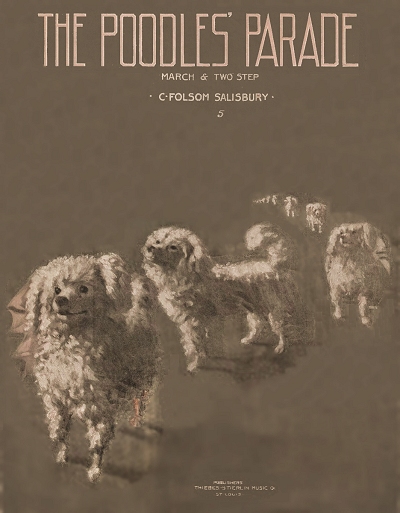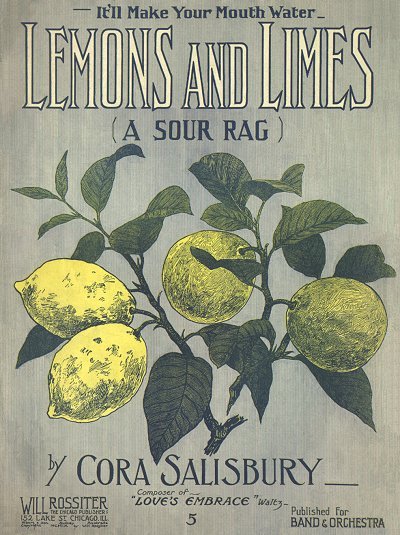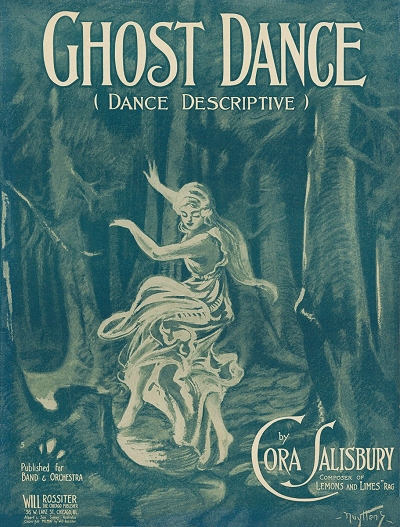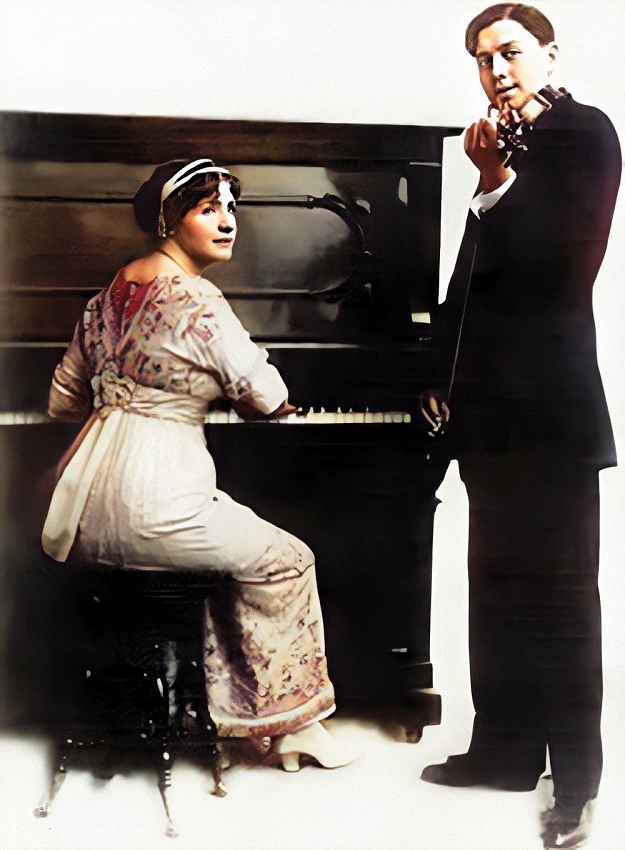|
Cora May Folsom Salisbury Aulmann (February 12, 1868 to April 16, 1916) | |
 Compositions Compositions | |
|
1906
Paula (Valse Caprice)1907
The Poodles Parade1908
My Light Guitar: Spanish IntermezzoPleading Eyes | |
It seems that there are two different schools of people who know at least something about Cora Salisbury - those who study or play ragtime piano, and those who know of her great protégé Benjamin Kubelsky. The story of both will be melded together in this account, although Kubelsky in his later years, to his great credit, always made sure they were intertwined.
Cora was born in Wisconsin in the winter of 1868 to Maine native James Harrison "Harry" Folsom and his bride Eliza Ann Knofsker, their only child. For the 1870 enumeration the family was found living in Oshkosh, Wisconsin, along with James' younger brother Benjamin Folsom and his wife. Both brothers were working in the local saw mill, as lumber was a big Wisconsin industry in the exponentially expanding United States.The family was still living in Oshkosh, for the 1880 census, in which Harry was listed as a saw filer. In 1884 Harrison passed on. His widow, Eliza, started taking in boarders, something she would do throughout the next two decades.
In 1884 Harrison passed on. His widow, Eliza, started taking in boarders, something she would do throughout the next two decades.
 In 1884 Harrison passed on. His widow, Eliza, started taking in boarders, something she would do throughout the next two decades.
In 1884 Harrison passed on. His widow, Eliza, started taking in boarders, something she would do throughout the next two decades.Most of those who stayed at the Folsom boarding house turned out to be theatrical types in traveling troupes or Chautauquas, usually at the Grand Opera House in town. So Cora certainly had exposure to contemporary music and learned something about working on the stage. She had been learning piano throughout her teens. Cora was mentioned in a February, 1887 article in Oshkosh as performing for the Carriage Men at the Y.M.C.A. along with Mary A. Grundy and the Keystone Orchestra. As the article also mentions that the two girls were "of the normal school," it is possible that Cora was training to be a teacher. In April she was mentioned again, this time playing for Neff's Ball, a library benefit. Her name started appearing frequently in the local paper, over the next few years, sometimes in a social context, but often as a performer.
On June 6, 1888, Cora Folsom married newspaper editor Charles P. Salisbury, which could have been the end of a potential performance career. However she did work from time to time as an accompanist. Charles had been a newspaper man for several years, working as an editor for the Oshkosh Times, but eventually shifted careers and became the manager of the local Grand Opera House, then later in the 1890s the Great Northern Theater in Chicago.
There is no indication of whether Cora primarily played the role of housewife in the beginning or worked in music. However, it was publicly announced in 1897 that she had become a part of Charles' musical theater troupe, the Music Hall Stock Company, based at that time in Buffalo, New York where the couple had relocated the prior year. There were also branches in Milwaukee, Wisconsin, and Syracuse, New York, and in 1898 Charles added the Columbia Theater in Saint Louis, Missouri. At some point by the late 1890s the marriage, which was childless, became contentious according to the family. While in Buffalo in the late 1890s, both mother and daughter fostered a relationship with Eliza's cousin Frances Folsom Cleveland, the wife of former President Grover Cleveland, the only man to serve two non-consecutive terms in that office.
the Music Hall Stock Company, based at that time in Buffalo, New York where the couple had relocated the prior year. There were also branches in Milwaukee, Wisconsin, and Syracuse, New York, and in 1898 Charles added the Columbia Theater in Saint Louis, Missouri. At some point by the late 1890s the marriage, which was childless, became contentious according to the family. While in Buffalo in the late 1890s, both mother and daughter fostered a relationship with Eliza's cousin Frances Folsom Cleveland, the wife of former President Grover Cleveland, the only man to serve two non-consecutive terms in that office.
 the Music Hall Stock Company, based at that time in Buffalo, New York where the couple had relocated the prior year. There were also branches in Milwaukee, Wisconsin, and Syracuse, New York, and in 1898 Charles added the Columbia Theater in Saint Louis, Missouri. At some point by the late 1890s the marriage, which was childless, became contentious according to the family. While in Buffalo in the late 1890s, both mother and daughter fostered a relationship with Eliza's cousin Frances Folsom Cleveland, the wife of former President Grover Cleveland, the only man to serve two non-consecutive terms in that office.
the Music Hall Stock Company, based at that time in Buffalo, New York where the couple had relocated the prior year. There were also branches in Milwaukee, Wisconsin, and Syracuse, New York, and in 1898 Charles added the Columbia Theater in Saint Louis, Missouri. At some point by the late 1890s the marriage, which was childless, became contentious according to the family. While in Buffalo in the late 1890s, both mother and daughter fostered a relationship with Eliza's cousin Frances Folsom Cleveland, the wife of former President Grover Cleveland, the only man to serve two non-consecutive terms in that office.By 1900 mother and daughter were found residing in Washington D.C. for the census, with Eliza now running a boarding house for members of congress and their aides, and Cora as a saleswoman for an indeterminate product (the garbled text looks like "toilet" but could be "toiletries"). Mentions of Charles' company are difficult to locate, so they may have been there independently of him. The pair returned to Buffalo in 1901, likely due to her husband's current production company of A Trip to Buffalo performing there. Cora was at the Buffalo Pan American Exposition on September 6, 1901, in the Temple of Music hall (cannot confirm if it was in a performance capacity), and was reportedly standing in very close proximity to President William McKinley when the attempt on his life was made by Leon Frank Czolgosz at 4:07 PM. McKinley would die eight days later from infections sustained from inadequate medical attention when attempts were made to remove one of the two bullets.
During this period it is unclear how often Charles was traveling together with Cora and Eliza due to the marital tension. However, in November of 1901 an article in The Daily Northwestern in Oshkosh cites his role as the producer of A Trip to Buffalo which had recently returned from playing in Buffalo for a short run in Oshkosh. It also indicated that Cora was accompanying him on the Eastern tour of the play. But their marriage was not to last. The couple legally called it quits with a final divorce in November of 1903. As cited on the wires in May of that year:
which had recently returned from playing in Buffalo for a short run in Oshkosh. It also indicated that Cora was accompanying him on the Eastern tour of the play. But their marriage was not to last. The couple legally called it quits with a final divorce in November of 1903. As cited on the wires in May of that year:
 which had recently returned from playing in Buffalo for a short run in Oshkosh. It also indicated that Cora was accompanying him on the Eastern tour of the play. But their marriage was not to last. The couple legally called it quits with a final divorce in November of 1903. As cited on the wires in May of that year:
which had recently returned from playing in Buffalo for a short run in Oshkosh. It also indicated that Cora was accompanying him on the Eastern tour of the play. But their marriage was not to last. The couple legally called it quits with a final divorce in November of 1903. As cited on the wires in May of that year:Miss Cora Folsom Salisbury of New York is [in Oshkosh] for the purpose of prosecuting an action for divorce against Charles P. Salisbury, formerly of [Oshkosh]. The basis of this action is non-support. The defendant was manager at one time of the Great Northern Theater in Chicago.
Eliza and Cora were reported to have gone back to Oshkosh for a time to run another boarding house. Cora was able to focus even more on music while there, not only teaching piano but taking some time to compose as well. Through this period she kept the married name of Salisbury as it was the one in which she had gained her growing reputation as a stage pianist. Cora established a base in Waukegan, Illinois, just south of the Wisconsin border, by the middle of the decade maintaining it through the end of her life, but often spending time in Oshkosh with her mother.
It was around 1907 that Cora created her own comic vaudeville act and started to travel, most likely with a small troupe of other vaudeville performers. She is listed in a September, 1907 Oshkosh Daily Northwestern News article performing at the Bijou vaudeville theater, giving a pianologue. On November 23, the same newspaper noted that:
Mrs. Charles P. Salisbury, who is well known in Oshkosh as a pianist and vocalist, has taken up vaudeville with marked success. She has just had a trip through Michigan occupying two weeks, which she found delightful and successful. Now she has started on a tour of twelve weeks for which she has contracts to go through Missouri, Iowa, Illinois and Indiana, with two weeks in Chicago. After that it may be that she will go on a further tour, perhaps coming through Wisconsin. Mrs. Salisbury appears in vaudeville under the name of Miss Cora Folsom Salisbury. The Evening Gazette of Burlington, Ia., said of her appearance there last week: "Cora Folsom Salisbury, who is at the Garrick this week, says a pianologist is a person who plays a piano and then some. Miss Salisbury calls herself a pianologist. The word does not appear in the dictionary, but she gives a side-splitting definition of it three times a day. She says she has hopes that some day they may incorporate her title in some unabridged edition of the encyclopedia dictionary [to date it has not happened], but in the meantime she is content with demonstrating its possibilities on the vaudeville stage. Miss Salisbury has an act that is absolutely new. It is also irresistibly funny. She is a good-looking little woman, but is willing to sacrifice her good looks and graceful carriage at times to amuse the public. She has evidently made a close study of the different methods different women pursue in playing the piano and she sings one song that is alone worth the money, entitled 'I Would if I Could, but I'b Married.' She says she finds the general public appreciates a 'pianologist' better than a pianist, and besides, the former can make more money."
One of Cora's earliest published compositions was the waltz Paula in 1906, dedicated to vaudeville actress Paula Edwardes, who she had worked with on a few occasions. It was followed by Poodles Parade in 1907, printed by Thiebes Stierlin in St. Louis, where Charles still managed the Columbia theater. All of her Saint Louis pieces were published as C. Folsom Salisbury. The following year saw another piece in print, My Light Guitar under the logo of Will Rossiter in Chicago, extremely hard to locate today so likely issued as a small run. In 1909 her most second most famous piece found its way into print, Lemons and Limes: A Sour Rag, also published by Rossiter.
In the 1910 census it is difficult to pinpoint either Cora or Eliza, so one or both may have simply missed the enumerator while on the road. Cora's mailing address as listed a few months earlier in 1909 was the Barrison Theater in Waukegan. One more composition would come from Cora during these years of travel, even though she was still based in Wisconsin. This was Ghost Dance, a novelette published by Rossiter. Ghost Dance was frequently performed in and out of vaudeville all around the country over the next several years. One other piece, Love's Embrace, was copyrighted and issued in 1913, but may have been written prior to that as it was mentioned on the covers of some previously issued music sheets. That would be the end of published compositions by Cora Salisbury, but one of her best acts was yet to come.
One more composition would come from Cora during these years of travel, even though she was still based in Wisconsin. This was Ghost Dance, a novelette published by Rossiter. Ghost Dance was frequently performed in and out of vaudeville all around the country over the next several years. One other piece, Love's Embrace, was copyrighted and issued in 1913, but may have been written prior to that as it was mentioned on the covers of some previously issued music sheets. That would be the end of published compositions by Cora Salisbury, but one of her best acts was yet to come.
 One more composition would come from Cora during these years of travel, even though she was still based in Wisconsin. This was Ghost Dance, a novelette published by Rossiter. Ghost Dance was frequently performed in and out of vaudeville all around the country over the next several years. One other piece, Love's Embrace, was copyrighted and issued in 1913, but may have been written prior to that as it was mentioned on the covers of some previously issued music sheets. That would be the end of published compositions by Cora Salisbury, but one of her best acts was yet to come.
One more composition would come from Cora during these years of travel, even though she was still based in Wisconsin. This was Ghost Dance, a novelette published by Rossiter. Ghost Dance was frequently performed in and out of vaudeville all around the country over the next several years. One other piece, Love's Embrace, was copyrighted and issued in 1913, but may have been written prior to that as it was mentioned on the covers of some previously issued music sheets. That would be the end of published compositions by Cora Salisbury, but one of her best acts was yet to come.From perhaps 1905 on, one place in particular that was frequented by Cora in her capacity as a pianist when she was not traveling was the Barrison Theatre in Waukegan, Illinois. By 1910 she had become a regular there and was the musical director of the Barrison orchestra. Around the same time she met a talented violinist who had joined the orchestra at age 15 in 1909. Benjamin Kubelsky, who was soon expelled from high school as he missed classes in favor of matinee performances, was being paid around eight dollars per week, so to him life seemed good. His Polish immigrant father, Mayer Kubelsky, had placed a violin in the young boy's hand and insisted on lessons for him so he could become a great classical violinist. Benjamin had other plans, as it turns out. Cora soon took some notice of Kubelsky, and there is a probability that he went on at least one of her vaudeville tours in early 1911 as an extra performer.
By September of 1911, sometime after the Barrison Theatre went out of business, Cora managed to convince Kubelsky's parents, who on religious grounds felt that the theater would ruin their son, that he had a future in vaudeville and convinced them that he should travel with her in a single act. They had already nixed an offer made to Benjamin by Minnie Palmer, mother of the Marx Brothers, to travel with their small troupe as an orchestra leader. Cora promised to keep an eye on the teenager at all times so he would not be corrupted by admirers at the stage door or even on the stage. This act was meant to be strictly musical, not with comic patter. Mr. Kubelsky finally consented.
In their class act, the large-busted Cora often wore a blue velvet dress with rhinestone earrings, and even a tiara from time to time for effect. Benjamin's father had obtained a tuxedo from his father as a present for the tour, which became Benny's standard stage dress.
 |
The original name of the traveling act was Salisbury and Kubelsky: From Grand Opera to Ragtime. However, a legal wrinkle created a change. Another much more famous violinist, Jan Kubelik, was using a similar title for his own traveling show, and was ready to bring legal action against Salisbury if they did not change the name of their act. Since they had seen some success in their short tenure, the answer was to change the name of one of the actors. Therefore Benjamin Kubelsky became Ben K. Benny (or Bennie). Still touring with their Opera to Ragtime act, now billed as Cora Salisbury and Benny, they were, as Benny put it later, "killing audiences" around the circuit. Among the pieces played in their shows included Cora's own compositions, plus popular songs like Everybody's Doing It by Irving Berlin, one or more renditions of the Turkey Trot, the poignant classically-based song The Rosary, and the old standard Poet and Peasant Overture. At several points in a show Benny would exaggerate the difficulty of the music by moving the violin dramatically, and keeping the pinky finger of his bow hand extended. As he later recalled, "I was an actor playing the role of a violinist." Over the two seasons that they traveled, the act went through a number of changes, eventually infusing a little bit of comedy, and also seeing some name changes. In October, 1912, the pair played in Oshkosh where Cora was warmly welcomed during a week of a well-documented homecoming.
In 1914 Eliza had become ill and needed more frequent care. So Cora had to abandon the act with Ben Benny and return to Waukegan to care for her mother. Ben eventually teamed up with pianist Lyman Woods and would reprise the act as Bennie and Woods: From Grand Opera to Ragtime. But again, the question of what's in a name came up when another established bandleader named Ben Bennie took exception with Ben Benny, believing that the youngster was trading on his good name. Another change was instituted, along with infusion of a little more comedy, and the career of comedian Jack Benny was born. He would forever remember with gratitude the role that Cora had played in refining his stage skills and getting him out in front of the public.
Now retired from the stage, Cora got married again on October 7, 1914, this time to Navy Warrant Officer George L. Aulmann. He had been stationed at the Great Lakes Naval Training Station in Waukegan, Illinois, working as the chief yeoman, but they were married at South Bend, Indiana. Cora and her mother then resided with George in Waukegan.
Eliza died on November 11, 1915 and was buried in her beloved long time home of Oshkosh. Cora's health quickly deteriorated after the loss of her mother and she remained in ill health for the next five months. She went to Fond du Lac, Wisconsin, for a stay in a sanitarium, during which she recovered somewhat. On April 9, 1916, Cora was hospitalized for an attack of peritonitis. She appeared to be recovering several days later when she had a sudden turn early in the morning of April 16, dying in minutes, even before George was able to get to the hospital from the Naval base after having been called by the hospital. She was only 48 years of age at that time. George was now a widower after a mere 18 months. He would move back to California and remarry in the 1920s.
As per Cora's final wishes she was buried beside Eliza in Oshkosh at the Riverside cemetery. However, through her rags, and through the success of her finest student of the stage, the delightful and beloved comedian Jack Benny, she lives on well beyond her relatively fruitful time on Earth.
Some of the information here was derived from various interviews of Jack Benny published over the years. Thanks also go to ragtime enthusiast and MIDI performer John Cowles who sent along some of the family information presented here, which was gathered by distant relation Tammy Wright through the writings of her grandmother, Dorothy Shorey Gavin. Much of the information on George Aulman was further clarified and corrected by women of ragtime researcher Nora Hulse. The remaining information was researched by the author in public records and publisher listings.